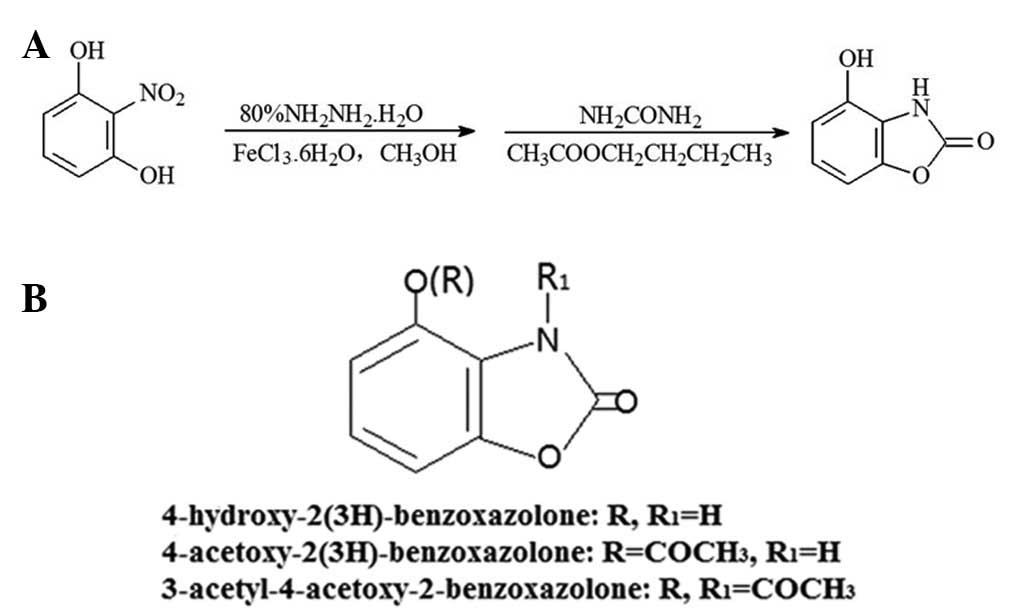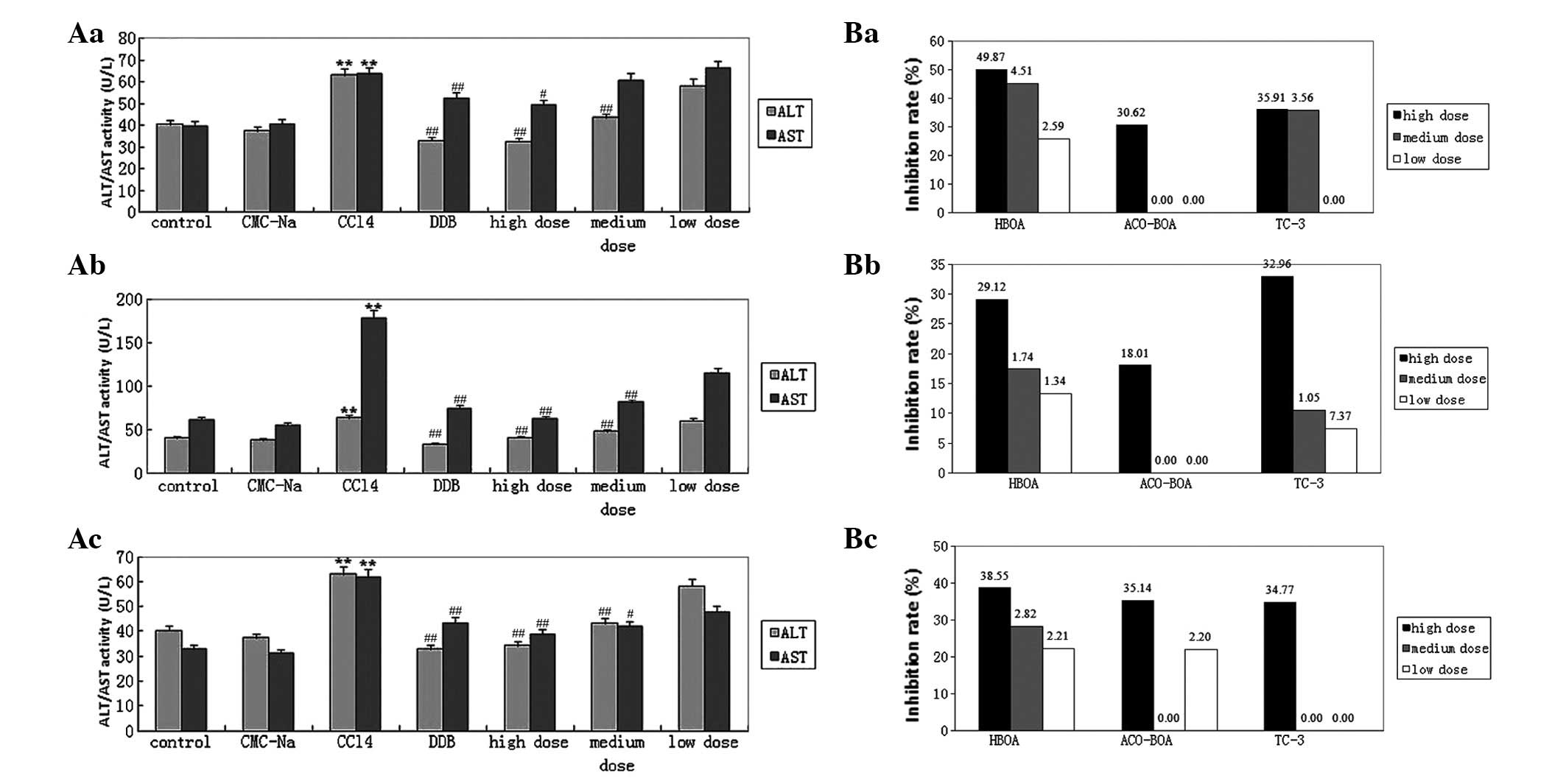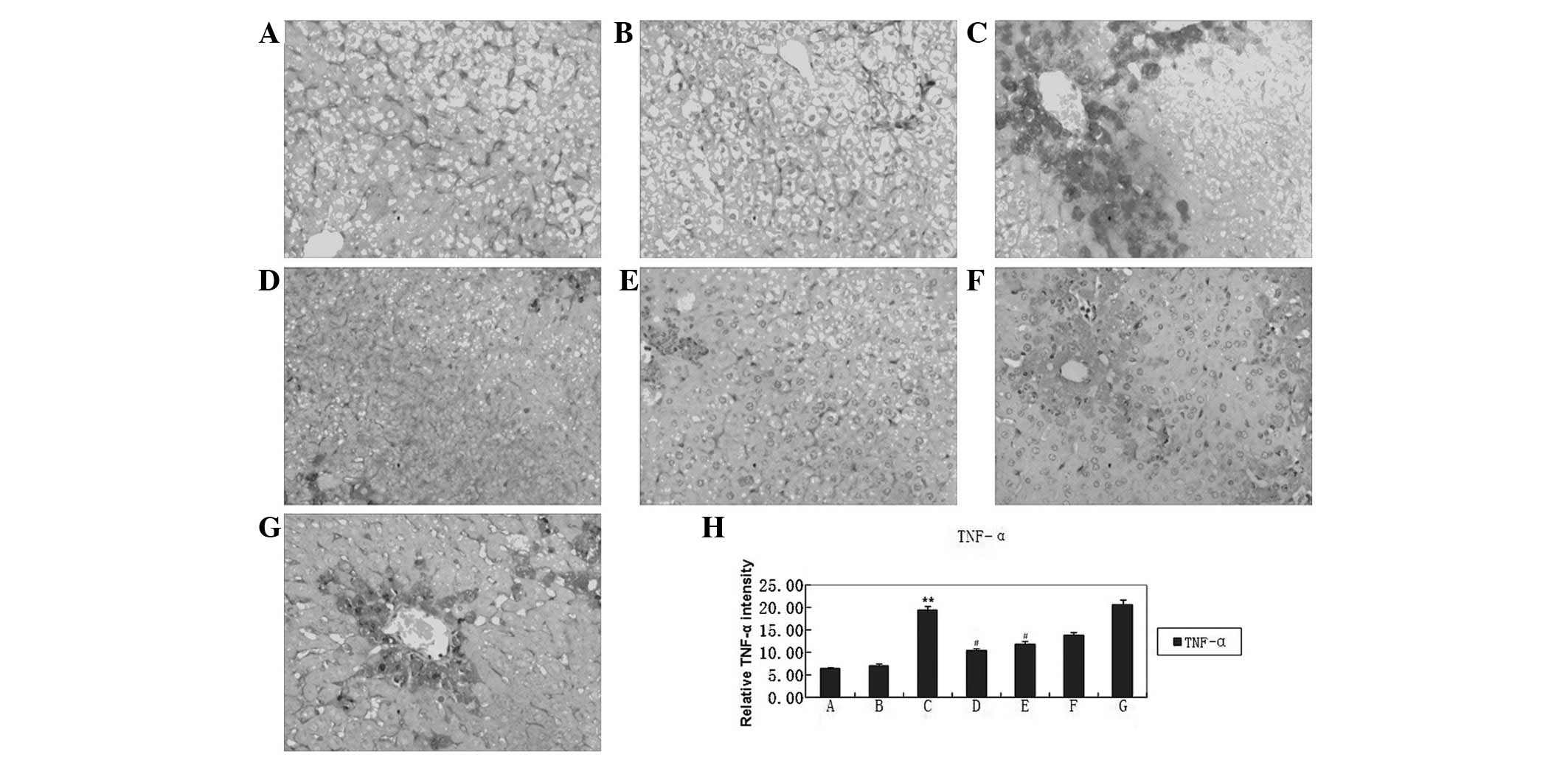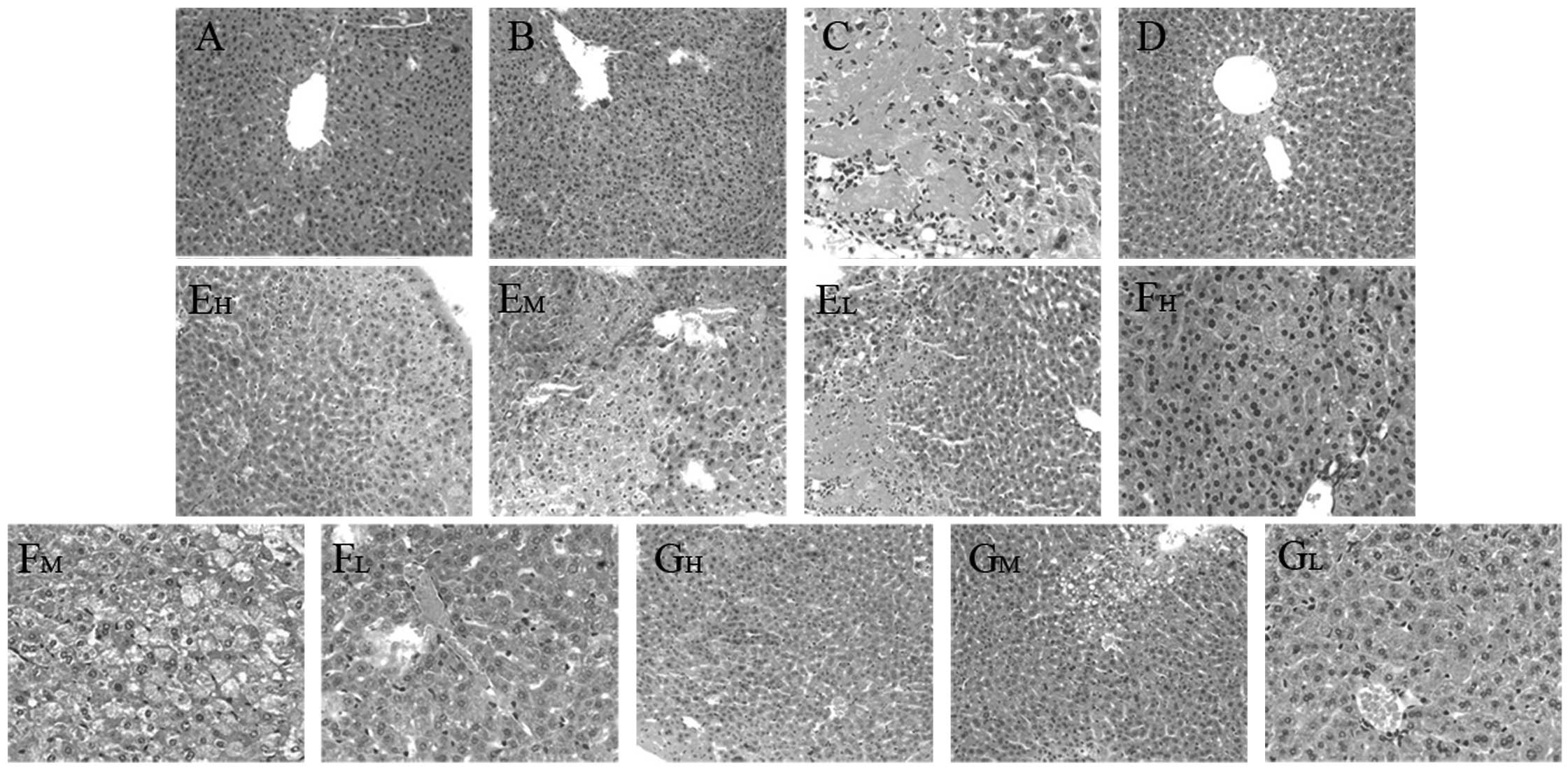|
1
|
Spiteller G: Are lipid peroxidation
processes induced by changes in the cell wall structure and how are
these processes connected with diseases? Med Hypotheses. 60:69–83.
2003. View Article : Google Scholar : PubMed/NCBI
|
|
2
|
Amin A and Mahmoud-Ghoneim D: Zizyphus
spina-christi protects against carbon tetrachloride-induced
liver fibrosis in rats. Food Chem Toxicol. 47:2111–2119. 2009.
View Article : Google Scholar
|
|
3
|
Lin HM, Tseng HC, Wang CJ, Lin JJ, Lo CW
and Chou FP: Hepatoprotective effects of Solanum nigrum Linn
extract against CCl4-induced oxidative damage in rats.
Chem Biol Interact. 171:283–293. 2008.
|
|
4
|
Wang CY, Ma FL, Liu JT, Tian JW and Fu FH:
Protective effect of salvianic acid A on acute liver injury induced
by carbon tetrachloride in rats. Biol Pharm Bull. 30:44–47. 2007.
View Article : Google Scholar : PubMed/NCBI
|
|
5
|
Babu BH, Shylesh BS and Padikkala J:
Antioxidant and hepatoprotective effect of Acanthus
ilicifolius. Fitoterapia. 72:272–277. 2001. View Article : Google Scholar : PubMed/NCBI
|
|
6
|
Babu BH, Shylesh BS and Padikkala J:
Tumour reducing and anticarcinogenic activity of Acanthus
ilicifolius in mice. J Ethnopharmacol. 79:27–33. 2002.
View Article : Google Scholar : PubMed/NCBI
|
|
7
|
Ganesh S and Vennila JJ: Screening for
antimicrobial activity in Acanthus ilicifolius. Arch Appl
Sci Res. 2:311–315. 2010.
|
|
8
|
Poupaert J, Carato P, Colacino E and Yous
S: 2(3H)-Benzoxazolone and bioisosters as ‘privileged scaffold’ in
the design of pharmacological probes. Curr Med Chem. 12:877–885.
2005.PubMed/NCBI
|
|
9
|
Gulcan HO, Kupeli E, Unlu S, Yesilada E
and Sahin MF: 4-(5-chloro-2(3H)-benzoxazolon-3-yl) butanoic acid
derivatives: synthesis, antinociceptive and anti-inflammatory
properties. Arch Pharm (Weinheim). 336:477–482. 2003. View Article : Google Scholar : PubMed/NCBI
|
|
10
|
Tang L, Ban SR, Feng XE, Lin WH and Li QS:
Synthesis and activities of new 4-hydroxy benzoxazolone
derivatives. Chin Chem Lett. 21:63–66. 2010. View Article : Google Scholar
|
|
11
|
Gülcan HO, Ünlü S, Banoğlu E, Şahin MF,
Küpeli E and Yeşilada E: Synthesis of new
4-(5-chloro-2-oxo-3Hbenzoxazol-3-yl) butanamide derivatives and
their analgesic and anti-inflammatory properties. Turk J Chem.
27:467–476. 2003.
|
|
12
|
Charlier C and Michaux C: Dual inhibition
of cyclooxygenase-2 (COX-2) and 5-lipoxygenase (5-LOX) as a new
strategy to provide safer non-steroidal anti-inflammatory drugs.
Eur J Med Chem. 38:645–659. 2003. View Article : Google Scholar : PubMed/NCBI
|
|
13
|
Önkol T, Sahin MF, Yildirim E, Erol K and
Ito S: Synthesis and antinociceptive activity of
(5-chloro-2(3H)-benzoxazolon-3-yl) propanamide derivatives. Arch
Pharm Res. 27:1086–1092. 2004.PubMed/NCBI
|
|
14
|
Wang ZY, Chen YH, Zheng GJ, Yang CM and
Long SJ: Study on the anti-inflammatory and analgesic effects of
ilicifolius alkaloids A and its derivatives acetyl ilicifolius
alkaloids A. Chin Hosp Pharm J. 31:807–810. 2011.
|
|
15
|
Soyer Z, Bas M, Pabuccuoglu A and
Pabuccuoglu V: Synthesis of some 2(3H)-benzoxazolone derivatives
and their in-vitro effects on human leukocyte myeloperoxidase
activity. Arch Pharm (Weinheim). 338:405–410. 2005. View Article : Google Scholar
|
|
16
|
Ucar H, Van derpoorten K, Cacciaguerra S,
Spampinato S, Stables JP, Depovere P, Isa M, Masereel B, Delarge J
and Poupaert JH: Synthesis and anticonvulsant activity of 2(3
H)-benzoxazolone and 2(3H)-benzothiazolone derivatives. J Med Chem.
41:1138–1145. 1998. View Article : Google Scholar : PubMed/NCBI
|
|
17
|
Bell M, Crowell T, Matthews D, Mcdonald J,
Neel D and Shuker A: Selective β3 adrenergic agonists. US Patent
5,786,356. Filed June 25, 1997; issued July 28, 1998.
|
|
18
|
Lin J and Fan H: Effect of
4-hydroxy-2-benzoxazolone on the proliferation of HSC-T6 cells.
Lishizhen Med Materia Medica Res. 10:2371–2372. 2011.
|
|
19
|
Wei CM: Optimizing the preparation process
for 2-nitroresorcinol. J Huaiyin Teach (Nat Sci). 3:135–138.
2004.
|
|
20
|
Calış Ü, Gökhan N and Erdoğan H: Synthesis
of some novel 3-methyl-6-(2-substituted
propanoyl/propyl)-2-benzoxazolinone derivatives and
anti-nociceptive activity. Farmaco. 56:719–724. 2001.PubMed/NCBI
|
|
21
|
Wei X, Chen YH and Long SJ: Synthesis of
2-aminoresorcinol hydrochloride. Northwest Pharmaceutical Journal.
3:168–169. 2008.
|
|
22
|
Recknagel RO, Glende EA Jr, Dolak JA and
Waller RL: Mechanisms of carbon tetrachloride toxicity. Pharmacol
Ther. 43:139–154. 1989. View Article : Google Scholar : PubMed/NCBI
|
|
23
|
Yu J, Wang Y, Qian H, Zhao Y, Liu B and Fu
C: Polyprenols from Taxus chinensis var. mairei prevent the
development of CCl4-induced liver fibrosis in rats. J
Ethnopharmacol. 142:151–160. 2012.
|
|
24
|
Al-Dbass AM, Al-Daihan SK and Bhat RS:
Agaricus blazei Murill as an efficient hepatoprotective and
antioxidant agent against CCl4-induced liver injury in
rats. Saudi J Biol Sci. 19:303–309. 2012. View Article : Google Scholar
|
|
25
|
Domitrović R, Jakovac H and Blagojević G:
Hepatoprotective activity of berberine is mediated by inhibition of
TNF-α, COX-2, and iNOS expression in CCl4-intoxicated
mice. Toxicology. 280:33–43. 2011.PubMed/NCBI
|
|
26
|
Schwabe RF and Brenner DA: Mechanisms of
liver injury. I TNF-alpha-induced liver injury: role of IKK, JNK
and ROS pathways. Am J Physiol Gastrointest Liver Physiol.
290:G583–G589. 2006. View Article : Google Scholar : PubMed/NCBI
|













